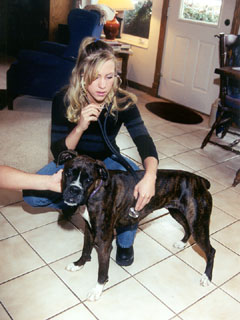E122
Coughing/Gagging
Introduction:
Coughing or gagging is a common problem found in dogs. Coughing is sometimes
confused with panting, shortness of breath, sneezing,
reverse sneezing, wheezing, retching, gagging, choking, and attempted vomiting.
Severe coughing fits may often be followed by retching or vomiting which can
confuse a pet owner into thinking a cough is actually an upset stomach.
Causative Agents: A cough generally occurs because of an abnormality in
the lower respiratory system (trachea, bronchi, lungs).
Abnormalities include irritation to the sensitive tissues lining the airways (kennel cough
or other viral/bacterial infection), pressure from nearby structures on the
airways (heart or lymph node enlargement), or fluid leaking into the airways or
air sacs of the lungs (rodenticide poisoning or pneumonia). Coughing can also be
caused by heart disease and cancer in the lungs or other structures. These are
only a few of the many causes.
Clinical Signs: A cough, just as in people, is a forceful expulsion of
air from the lungs. A cough may be dry or moist in its sound, may or may not be
productive (meaning that it brings up a substance such as mucus or blood, which
may be expelled or swallowed), and may be worse at certain times of the day. All
these pieces of information are valuable to the veterinarian.
Diagnosis: History and physical examination comprise the beginning
point for making a diagnosis. As part of the physical exam, the lungs are often
listened to with a stethoscope (see below, A560,
and B890 for additional help). This
beginning point alone may be sufficient for diagnosing mild cases of infectious
tracheobronchitis (kennel cough) and a few other causes of coughing. Radiographs
of the lungs and heart, however, are a very high priority for a dog with a
cough. By using radiographs, the lungs and the patterns which occur in the lungs
of a coughing dog can be observed. This is extremely helpful in determining the
cause of a particular coughing problem. Other tests which may be recommended
include bloodwork (CBC, blood chemistry profile,
coagulation profile), urine analysis, transtracheal wash
(TTW), and ultrasound of the heart (echocardiography).
See Section D for detailed information on many of the above tests.
Treatment: Any disease causing a cough has the ability to lower the
natural defenses of the lungs, giving an opportunity for tiny organisms
(bacteria, viruses, etc.) to cause an infection. Because bacteria and other
infectious agents are constantly being inhaled and brought into contact with the
delicate lining inside the lungs, antibiotic therapy is recommended in a high
percentage of coughing dogs.
Other types of therapy which may be utilized include medication to improve
the function of a failing heart, diuretics which may be helpful in pulling fluid
from the lungs, antidotes for some types of poison (i.e. rodenticide poisoning),
anti-inflammatory agents, airway dilating agents, surgery, chemotherapy, oxygen
therapy, and fluid therapy. Because coughing may actually prove beneficial in
many coughing conditions (such as pneumonia), anti-tussive therapy (drugs which
suppress coughing) is utilized only occasionally. Coughing may also provide a
gauge on how the pet is responding to medication.
Prevention: Many of the infectious problems causing a cough can be
avoided through routine vaccinations and basic disease prevention techniques.
Avoiding exposure to other infected animals will also reduce the occurrence of
this problem. Careful monitoring of a petís respirations and lung sounds will
greatly enhance the chances of detecting a problem early in its progression.
This increases the chance for a rapid and successful recovery. See pages B890
and A560 for additional
suggestions on how to monitor the respiratory system of a pet.
In general, any animal with a productive cough (especially if blood or pus is
expelled), a lingering cough of more than a week, or with other signs of illness
such as listlessness or poor appetite, should be taken to a veterinarian as soon
as possible.

|
|
|
| With
practice, normal and abnormal lung sounds can be identified. See
pages A560 and B890 for normal respiratory rates and additional
suggestions.
Note :
Signs of respiratory problems include
nasal discharge, coughing, rapid breathing, and sneezing. |
|
